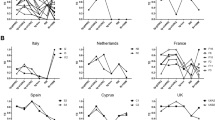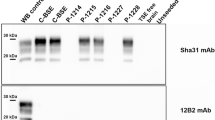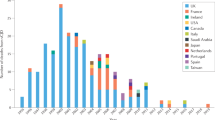Abstract
There are many strains of the agents that cause transmissible spongiform encephalopathies (TSEs) or ‘prion’ diseases. These strains are distinguishable by their disease characteristics in experimentally infected animals, in particular the incubation periods and neuropathology they produce in panels of inbred mouse strains1,2,3,4. We have shown that the strain of agent from cattle affected by bovine spongiform encephalopathy (BSE) produces a characteristic pattern of disease in mice that is retained after experimental passage through a variety of intermediate species5,6,7. This BSE ‘signature’ has also been identified in transmissions to mice of TSEs of domestic cats and two exotic species of ruminant6,8, providing the first direct evidence for the accidental spread of a TSE between species. Twenty cases of a clinically and pathologically atypical form of Creutzfeldt–Jakob disease (CJD), referred to as ‘new variant’ CJD (vCJD)9, have been recognized in unusually young people in the United Kingdom, and a further case has been reported in France10. This has raised serious concerns that BSE may have spread to humans, putatively by dietary exposure. Here we report the interim results of transmissions of sporadic CJD and vCJD to mice. Our data provide strong evidence that the same agent strain is involved in both BSE and vCJD.
This is a preview of subscription content, access via your institution
Access options
Subscribe to this journal
Receive 51 print issues and online access
$199.00 per year
only $3.90 per issue
Buy this article
- Purchase on Springer Link
- Instant access to full article PDF
Prices may be subject to local taxes which are calculated during checkout



Similar content being viewed by others
References
Dickinson, A. G. & Meikle, V. M. H. Host-genotype and agent effects in scrapie incubation: change in allelic interaction with different strains of agent. Mol. Gen. Genet. 112, 73–79 (1971).
Fraser, H. & Dickinson, A. G. Scrapie in mice: agent-strain differences in the distribution and intensity of grey matter vacuolation. J. Comp. Pathol. 83, 29–40 (1973).
Bruce, M. E., McConnell, I., Fraser, H. & Dickinson, A. G. The disease characteristics of different strains of scrapie in Sinc congenic mouse lines: implications for the nature of the agent and host control of pathogenesis. J. Gen. Virol. 72, 595–603 (1991).
Bruce, M. E. Scrapie strain variation and mutation. Br. Med. Bull. 49, 822–838 (1993).
Fraser, H., Bruce, M. E., Chree, A., McConnell, I. & Wells, G. A. Transmission of bovine spongiform encephalopathy and scrapie to mice. J. Gen. Virol. 73, 1891–1897 (1992).
Bruce, M. et al. Transmission of bovine spongiform encephalopathy and scrapie to mice: strain variation and the species barrier. Phil. Trans. R. Soc. Lond. B 343, 405–411 (1994).
Foster, J. D., Bruce, M., McConnell, I., Chree, A. & Fraser, H. Detection of BSE infectivity in brain and spleen of experimentally infected sheep. Vet. Rec. 138, 546–548 (1996).
Fraser, H. et al. Transmission of feline spongiform encephalopathy to mice. Vet. Rec. 134, 449 (1994).
Will, R. G. et al. Anew variant of Creutzfeldt–Jakob disease in the UK. Lancet 347, 921–925 (1996).
Chazot, G. et al. New variant of Creutzfeldt–Jakob disease in a 26-year-old French man. Lancet 347, 1181 (1996).
Cousens, S. N. et al. Sporadic Creutzfeldt–Jakob disease in the United Kingdom: epidemiological data from 1970–1996. Br. Med. J. 315, 389–396 (1997).
Dickinson, A. G. in Slow Virus Diseases of Animals and Man (ed. Kimberlin, R. H.) 209–241 (North-Holland, Amsterdam, (1976)).
Carp, RI. & Callahan, S. M. Variation i nthe characteristics of 10 mouse-passaged scrapie lines derived from five scrapie-positive sheep. J. Gen. Virol. 72, 293–298 (1991).
Fraser, H., Behan, W., Chree, A., Crossland, G. & Behan, P. Mouse inoculation studies reveal no transmissible agent in amyotrophic lateral sclerosis. Brain Pathol. 6, 89–99 (1996).
Tateishi, J. Transmission of human prion diseases of rodents. Semin. Virol. 7, 175–180 (1996).
Tateishi, J., Ohta, M., Koga, M., Sato, Y. & Kuroiwa, Y. Transmission of chronic spongiform encephalopathy with kuru plaques from humans to small rodents. Ann. Neurol. 5, 581–584 (1979).
Tateishi, J. et al. First experimental transmission of fatal familial insomnia. Nature 376, 434–435 (1995).
Collinge, J., Sidle, K. C. L., Meads, J., Ironside, J. & Hill, A. F. Molecular analysis of prion strain variation and the aetiology of ‘new variant’ CJD. Nature 383, 685–690 (1996).
Hill, A. F., Will, R. G., Ironside, J. & Collinge, J. Type of prion protein in UK farmers with Creutzfeldt–Jakob disease. Lancet 350, 188 (1997).
Somerville, R. A. et al. Biochemical typing of scrapie strains. Nature 386, 564 (1997).
Telling, G. et al. Evidence for the conformation of the pathological isoform of the prion protein enciphering and propagating prion diversity. Science 274, 2079–2082 (1996).
Dickinson, A. G., Meikle, V. M. H. & Fraser, H. Identification of a gene which controls the incubation period of some strains of scrapie agent in mice. J. Comp. Pathol. 78, 293–299 (1968).
Westaway, D. et al. Distinct prion proteins in short and long scrapie incubation period mice. Cell 51, 651–662 (1987).
Fraser, H. & Dickinson, A. G. The sequential development of the brain lesions of scrapie in three strains of mice. J. Comp. Pathol. 78, 301–311 (1968).
Farquhar, C. F. et al. in Transmissible Spongiform Encephalopathies (eds Bradley, R. & Marchant, B.) 301–313 (Commission of the European Communities, Brussels, (1994)).
Bell, J. E. et al. Prion protein immunocytochemistry — UK five centre consensus report. Neuropathol. Appl. Neurobiol. 23, 26–35 (1997).
Kirkwood, B. R. Essentials of Medical Statistics (Blackwell, Oxford, (1988)).
Mardia, K. V., Kent, J. T. & Bibby, J. M. Multivariate Analysis (Academic, London, (1979)).
Acknowledgements
We acknowledge the contribution of A. Dickinson, who pioneered TSE strain discrimiantion in the 1960s. We also thank M. Brady, F. Purdie, L. Hunter, K. Lamza, S. Mack and other staff at the Neuropathogenesis Unit for technical support. This work was supported by the Department of Health, MRC, BBSRC and MAFF.
Author information
Authors and Affiliations
Corresponding author
Rights and permissions
About this article
Cite this article
Bruce, M., Will, R., Ironside, J. et al. Transmissions to mice indicate that ‘new variant’ CJD is caused by the BSE agent. Nature 389, 498–501 (1997). https://doi.org/10.1038/39057
Received:
Accepted:
Issue Date:
DOI: https://doi.org/10.1038/39057
This article is cited by
-
Classical bovine spongiform encephalopathy and chronic wasting disease: two sides of the prion coin
Animal Diseases (2023)
-
Detection of classical BSE prions in asymptomatic cows after inoculation with atypical/Nor98 scrapie
Veterinary Research (2023)
-
Inter- and intra-species conversion efficacies of Norwegian prion isolates estimated by serial protein misfolding cyclic amplification
Veterinary Research (2023)
-
Recombinant ovine prion protein can be mutated at position 136 to improve its efficacy as an inhibitor of prion propagation
Scientific Reports (2023)
-
New developments in prion disease research using genetically modified mouse models
Cell and Tissue Research (2023)
Comments
By submitting a comment you agree to abide by our Terms and Community Guidelines. If you find something abusive or that does not comply with our terms or guidelines please flag it as inappropriate.



